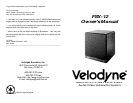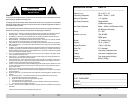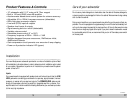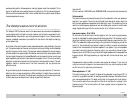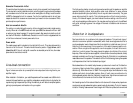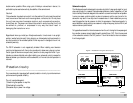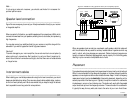
11 4
woofers actually add to the bass spectrum making it appear louder than recorded. This is
due to the additional and unwanted harmonics (distortion) of the fundamental signal.
While conventional subwoofers offer little to combat distortion products, we at Velodyne
have developed another way. . .
The Velodyne servo-control solution
–––––––––––––––––––––––––––––––––––––––––––––––––––—————–––
The Velodyne FSX-12 produces sound in the same manner as conventional loudspeakers:
a cone-shaped piston is forced to move by means of a linear motor composed of a coil
situated between the poles of a very strong permanent magnet. In our F-series products
however, a feedback mechanism is provided to link the driver to the amplifier creating a
control system loop.
At the heart of this control system is a low mass accelerometer rigidly attached to the voice
coil. The accelerometer continuously monitors cone motions, providing us with a feedback
signal for the servo control circuitry. This high-gain system is designed to improve linearity
and reduce distortion approximately 30 times over conventional non-servo systems. While
the input signal is being sent to the class AB amplifier which powers the driver, a continuous
signal representing cone motion is sent back to a comparator circuit. This circuit constantly
adjusts for any deviation between the input signal and the subwoofer's output. This self
regulation results in extreme control over cone movement, and very accurate low
distortion sound.
At typical listening levels, these servo controlled units produce less than 1% harmonic
distortion with input signals extending to 20Hz and below. Far better than conventional
designs currently on the market. This combination provides you with the best combination
of clean, deep, accurate bass, without making any sacrifice to distortion.
continued. . .
☞ ☞
Important!!!
Do not use both LINE LEVEL and SPEAKER LEVEL connections simultaneously!
Volume control
This control allows you to balance the output from the subwoofer to the main speakers/
amplifier in your system. This control should be set to achieve similar output level from
both the main speakers and subwoofer when listening to music. The remote may then be
used for minute/temporary adjustments, such as increasing the volume for home theater
usage. A good starting point for the volume control is 3 or 4 dots from minimum.
Low-pass crossover- 40 to 120Hz
All inputs sum the left and right channels together, with the resulting signal passing
through an adjustable low-pass crossover before being amplified. The crossover control
allows you to adjust the upper limit of the subwoofer's frequency response from 40 to
120Hz. The subwoofer's response will begin rolling off above the frequency you set this
control to. You should set the crossover frequency to obtain a smooth and seamless
transition from the subwoofer to the main speakers in your system. If your main speakers
are smaller units with limited low frequency output, you may wish to choose a higher
frequency (such as 100-120Hz) than you would with larger speakers which have greater low
frequency output. With larger speakers, you might start with this control set lower, such
as 80Hz.
A bypass switch is also provided if you wish to use an external crossover. If you are not
using an external crossover, we recommend that you use the one provided
within the unit for optimum performance!
Phase adjustment- 0˚/180˚
This control allows you the "reverse" the phase of the subwoofer's output signal 180˚ to
correct for any possible mismatch & resulting cancellation between the subwoofer and
your main speakers/amplifier. To adjust, simply listen to the system with music playing.
Then move the switch from one position to the other and listen for a change in low
frequency output. The correct position will have a greater amount of apparent low
frequency output.



